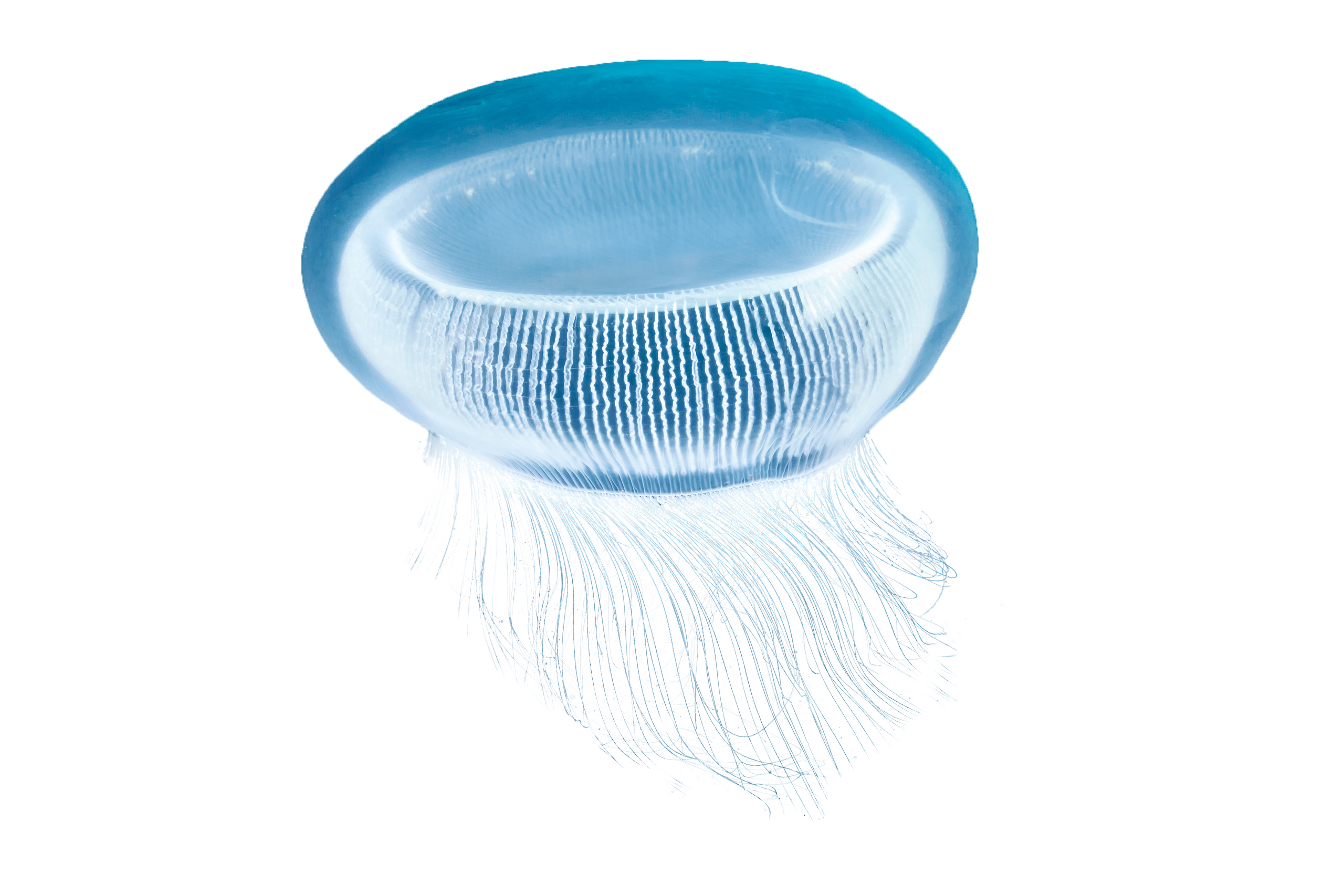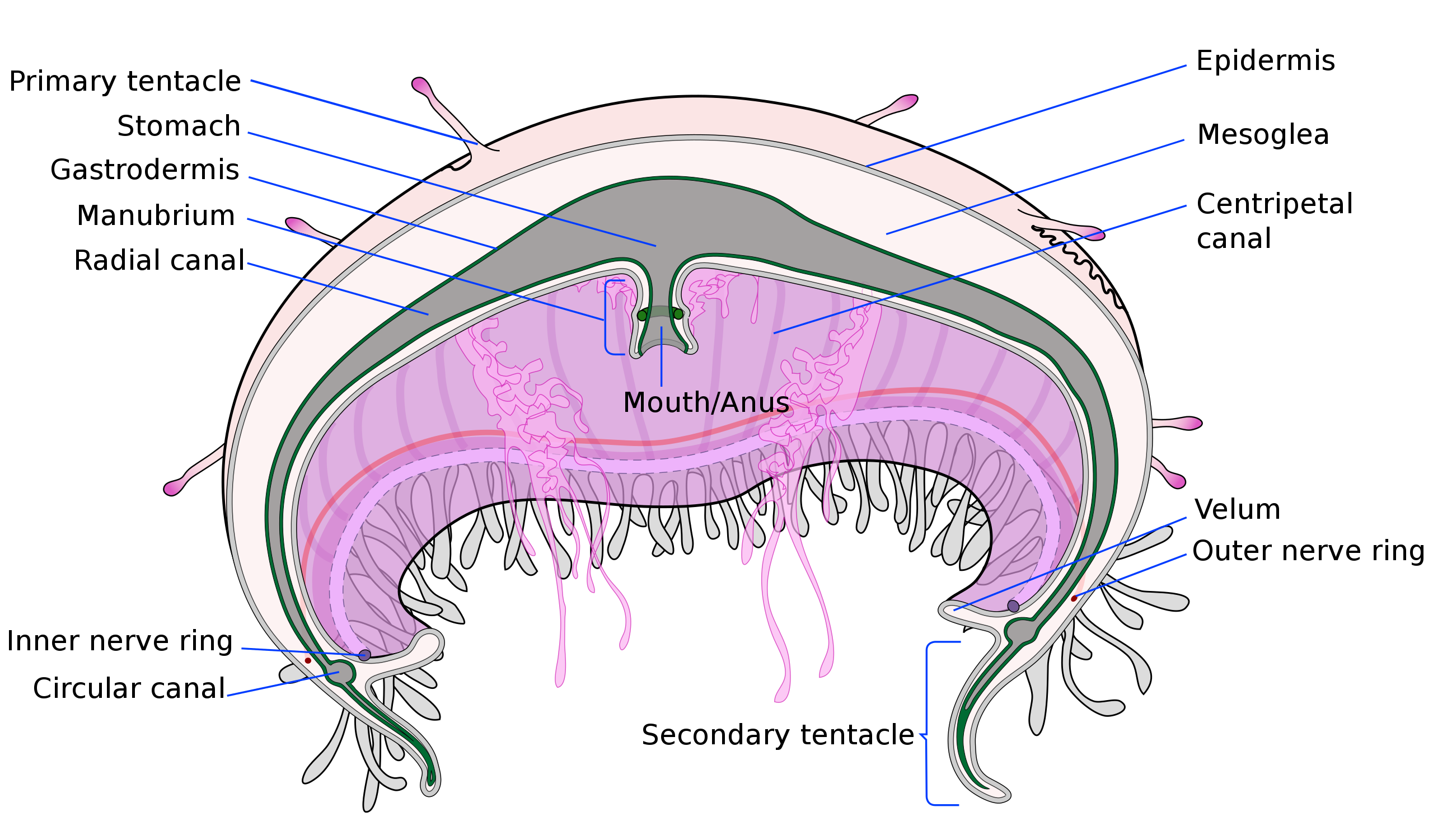Basic Anatomy

The main feature of a true jellyfish is the umbrella-shaped bell. This is a hollow structure consisting of a mass of transparent jelly-like matter known as mesoglea, which forms the hydrostatic skeleton of the animal.[24] 95% or more of the mesogloea consists of water,[29] but it also contains collagen and other fibrous proteins, as well as wandering amoebocytes which can engulf debris and bacteria. The mesogloea is bordered by the epidermis on the outside and the gastrodermis on the inside. The edge of the bell is often divided into rounded lobes known as lappets, which allow the bell to flex. In the gaps or niches between the lappets are dangling rudimentary sense organs known as rhopalia, and the margin of the bell often bears tentacles.[24]
On the underside of the bell is the manubrium, a stalk-like structure hanging down from the centre, with the mouth, which also functions as the anus, at its tip. There are often four oral arms connected to the manubrium, streaming away into the water below.[30] The mouth opens into the gastrovascular cavity, where digestion takes place and nutrients are absorbed. This is subdivided by four thick septa into a central stomach and four gastric pockets. The four pairs of gonads are attached to the septa, and close to them four septal funnels open to the exterior, perhaps supplying good oxygenation to the gonads. Near the free edges of the septa, gastric filaments extend into the gastric cavity; these are armed with nematocysts and enzyme-producing cells and play a role in subduing and digesting the prey. In some scyphozoans, the gastric cavity is joined to radial canals which branch extensively and may join a marginal ring canal. Cilia in these canals circulate the fluid in a regular direction.[24]

The box jellyfish is largely similar in structure. It has a squarish, box-like bell. A short pedalium or stalk hangs from each of the four lower corners. One or more long, slender tentacles are attached to each pedalium.[31] The rim of the bell is folded inwards to form a shelf known as a velarium which restricts the bell's aperture and creates a powerful jet when the bell pulsates, allowing box jellyfish to swim faster than true jellyfish.[24] Hydrozoans are also similar, usually with just four tentacles at the edge of the bell, although many hydrozoans are colonial and may not have a free-living medusal stage. In some species, a non-detachable bud known as a gonophore is formed that contains a gonad but is missing many other medusal features such as tentacles and rhopalia.[24] Stalked jellyfish are attached to a solid surface by a basal disk, and resemble a polyp, the oral end of which has partially developed into a medusa with tentacle-bearing lobes and a central manubrium with four-sided mouth.[24]

Most jellyfish do not have specialized systems for osmoregulation, respiration and circulation, and do not have a central nervous system. Nematocysts, which deliver the sting, are located mostly on the tentacles; true jellyfish also have them around the mouth and stomach.[32] Jellyfish do not need a respiratory system because sufficient oxygen diffuses through the epidermis. They have limited control over their movement, but can navigate with the pulsations of the bell-like body; some species are active swimmers most of the time, while others largely drift.[33] The rhopalia contain rudimentary sense organs which are able to detect light, water-borne vibrations, odour and orientation.[24] A loose network of nerves called a "nerve net" is located in the epidermis.[34][35] Although traditionally thought not to have a central nervous system, nerve net concentration and ganglion-like structures could be considered to constitute one in most species.[36] A jellyfish detects stimuli, and transmits impulses both throughout the nerve net and around a circular nerve ring, to other nerve cells. The rhopalial ganglia contain pacemaker neurones which control swimming rate and direction.[24]
In many species of jellyfish, the rhopalia include ocelli, light-sensitive organs able to tell light from dark. These are generally pigment spot ocelli, which have some of their cells pigmented. The rhopalia are suspended on stalks with heavy crystals at one end, acting like gyroscopes to orient the eyes skyward. Certain jellyfish look upward at the mangrove canopy while making a daily migration from mangrove swamps into the open lagoon, where they feed, and back again.[2] Box jellyfish have more advanced vision than the other groups. Each individual has 24 eyes, two of which are capable of seeing colour, and four parallel information processing areas that act in competition,[37] supposedly making them one of the few kinds of animal to have a 360-degree view of its environment.[38]